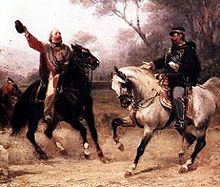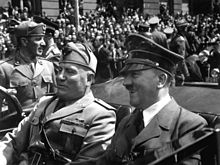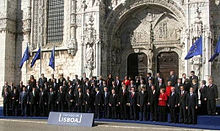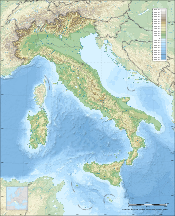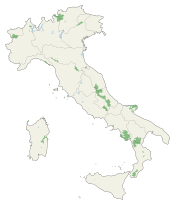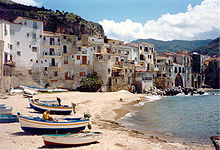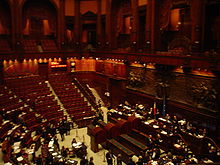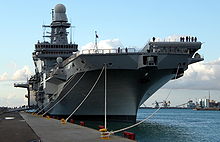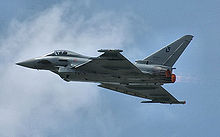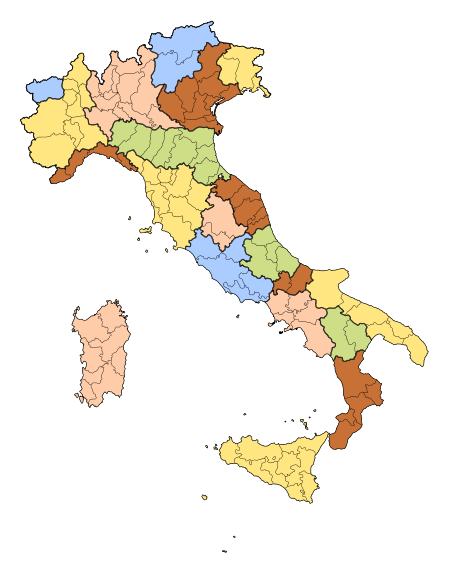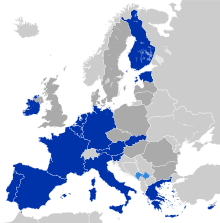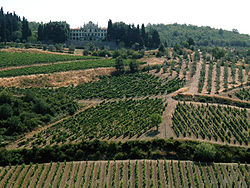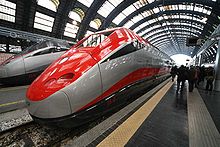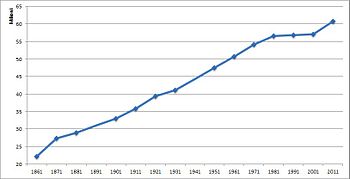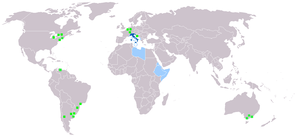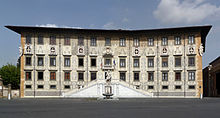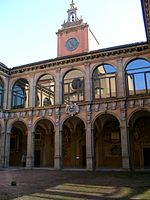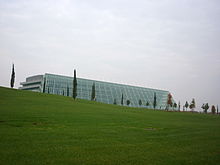
Italy
Background Information
This wikipedia selection has been chosen by volunteers helping SOS Children from Wikipedia for this Wikipedia Selection for schools. Child sponsorship helps children one by one http://www.sponsor-a-child.org.uk/.
| Italian Republic Repubblica italiana
|
||||||
|---|---|---|---|---|---|---|
|
||||||
| Anthem: Il Canto degli Italiani (Italian) The Song of the Italians |
||||||
|
Location of Italy (dark green)
– in Europe (green & dark grey) |
||||||
| Capital and largest city |
Rome 41°54′N 12°29′E |
|||||
| Official languages | Italian | |||||
| Demonym | Italian | |||||
| Government | Unitary parliamentary constitutional republic | |||||
| - | President | Giorgio Napolitano | ||||
| - | Prime Minister | Mario Monti | ||||
| - | President of the Senate |
Pietro Grasso | ||||
| - | President of the Chamber of Deputies | Laura Boldrini | ||||
| Legislature | Parliament | |||||
| - | Upper house | Senate of the Republic | ||||
| - | Lower house | Chamber of Deputies | ||||
| Formation | ||||||
| - | Unification | 17 March 1861 | ||||
| - | Republic | 2 June 1946 | ||||
| Area | ||||||
| - | Total | 301,338 km2 ( 71st) 116,347 sq mi |
||||
| - | Water (%) | 2.4 | ||||
| Population | ||||||
| - | 2012 estimate | 60,820,696 ( 23rd) | ||||
| - | 2011b census | 59,570,581 | ||||
| - | Density | 201.8/km2 ( 61st) 522.7/sq mi |
||||
| GDP ( PPP) | 2012 estimate | |||||
| - | Total | $1.834 trillion ( 10th) | ||||
| - | Per capita | $30,116 ( 29th) | ||||
| GDP (nominal) | 2012 estimate | |||||
| - | Total | $1.980 trillion ( 8th) | ||||
| - | Per capita | $32,522 ( 24th) | ||||
| Gini (2006) | 32 medium |
|||||
| HDI (2013) | very high · 25th |
|||||
| Currency | Euro ( €)c ( EUR) |
|||||
| Time zone | CET ( UTC+1) | |||||
| - | Summer ( DST) | CEST ( UTC+2) | ||||
| Drives on the | right | |||||
| Calling code | 39d | |||||
| ISO 3166 code | IT | |||||
| Internet TLD | .ite | |||||
| a. | French is co-official in the Aosta Valley; Slovene is co-official in the province of Trieste and the province of Gorizia; German and Ladin are co-official in the province of South Tyrol. | |||||
| b. | Preliminary results. | |||||
| c. | Before 2002, the Italian Lira. The euro is accepted in Campione d'Italia, but the official currency there is the Swiss Franc. | |||||
| d. | To call Campione d'Italia, it is necessary to use the Swiss code +41. | |||||
| e. | The .eu domain is also used, as it is shared with other European Union member states. | |||||
Italy / ˈ ɪ t ə l i / (Italian: Italia [iˈtaːlja]), officially the Italian Republic (Italian: Repubblica italiana), is a unitary parliamentary republic in Southern Europe. To the north, it borders France, Switzerland, Austria, and Slovenia along the Alps. To the south, it consists of the entirety of the Italian Peninsula, Sicily, Sardinia–the two largest islands in the Mediterranean Sea–and many other smaller islands. The independent states of San Marino and the Vatican City are enclaves within Italy, while Campione d'Italia is an Italian exclave in Switzerland. The territory of Italy covers some 301,338 km2 (116,347 sq mi) and is influenced by a temperate seasonal climate. With 60.8 million inhabitants, it is the fifth most populous country in Europe, and the 23rd most populous in the world.
Rome, the capital of Italy, has for centuries been a political and religious centre of Western civilisation as the capital of the Roman Empire and site of the Holy See. After the decline of the Roman Empire, Italy endured numerous invasions by foreign peoples, from Germanic tribes such as the Lombards and Ostrogoths, to the Byzantines and later, the Normans, among others. Centuries later, Italy became the birthplace of Maritime republics and the Renaissance. Through much of its post-Roman history, Italy was fragmented into numerous city and regional states (such as the Kingdom of Sardinia, the Republic of Venice and the Church State), but was unified in 1861. In the late 19th century, through World War I, and to World War II, Italy possessed a colonial empire.
Modern Italy is a democratic republic. It has been ranked as the world's 25th most-developed country and it Quality-of-life Index was ranked in the world's top ten in 2005. Italy enjoys a very high standard of living partially because of a high GDP per capita and has a high public education level. Italy is also one of the worlds most globalised nations. It is a founding member of what is now the European Union and part of the Eurozone. Italy is also a member of the G8, G20 and NATO. It has the world's third-largest gold reserves, eighth-largest nominal GDP, tenth highest GDP (PPP) and the sixth highest government budget in the world. It is also a member state of the Organisation for Economic Co-operation and Development, the World Trade Organization, the Council of Europe and the United Nations. Italy has the world's eleventh-largest defence budget and shares NATO's nuclear weapons.
Italy plays a prominent role in European and global military, cultural and diplomatic affairs. The country's European political, social and economic influence make it a major regional power.
Etymology
The assumptions on the etymology of the name "Italia" are very numerous and the corpus of the solutions proposed by historians and linguists is very wide. According to one of the more common explanations, the term Italia, from Latin: Italia, was borrowed through Greek from the Oscan Víteliú, meaning "land of young cattle" (cf. Lat vitulus "calf", Umb vitlo "calf"). The bull was a symbol of the southern Italian tribes and was often depicted goring the Roman wolf as a defiant symbol of free Italy during the Social War. Greek historian Dionysius of Halicarnassus states this account together with the legend that Italy was named after Italus, mentioned also by Aristotle and Thucydides.
The name Italia originally applied only to a part of what is now Southern Italy – according to Antiochus of Syracuse, the southern portion of the Bruttium peninsula (modern Calabria: province of Reggio, and part of the provinces of Catanzaro and Vibo Valentia). But by his time Oenotria and Italy had become synonymous, and the name also applied to most of Lucania as well. The Greeks gradually came to apply the name "Italia" to a larger region, but it was during the reign of Emperor Augustus (end of the first century BC) that the term was expanded to cover the entire peninsula until the Alps.
History
Prehistory and antiquity

Excavations throughout Italy reveal a Neanderthal presence dating back to the Paleolithic period, some 200,000 years ago, modern Humans arrived about 40,000 years ago. The Ancient peoples of pre-Roman Italy – such as the Umbrians, the Latins (from which the Romans emerged), Volsci, Samnites, the Celts and the Ligures which inhabited northern Italy, and many others – were Indo-European peoples; the main historic peoples of non-Indo-European heritage include the Etruscans, the Elymians and Sicani in Sicily and the prehistoric Sardinians.
Between the 17th and the 11th century BC Mycenaean Greeks established contacts with Italy and in the 8th and 7th centuries BC Greek colonies were established all along the coast of Sicily and the southern part of the Italian Peninsula became known as Magna Graecia. Also the Phoenicians established colonies on the coasts of Sardinia and Sicily.
Ancient Rome was at first a small agricultural community founded around the 8th century BC, that grew over the course of the centuries into a colossal empire encompassing the whole Mediterranean Sea, in which Ancient Greek and Roman cultures merged into one civilization. This civilization was so influential that its legacy is profound in the world. Ancient Rome heavily influenced and left its mark in modern government, law, politics, administration, urban planning, engineering, philosophy, architecture, arts and many more aspects in the western world, forming the ground that Western civilization is based upon.
In a slow decline since the late 2nd century AD, the empire finally broke into two parts in 395 AD: the Western Roman Empire and the Eastern Roman Empire. The western part – under the pressure of the Franks, the Vandals, the Huns, the Goths and other populations from Eastern Europe – finally dissolved in 476 AD, when the last western Emperor was deposed by the Barbarian chief Odoacer.
Middle Ages
After the fall of Rome, Italy was conquered by the Germanic Tribe of the Ostrogoths, but in the 6th century the East Roman Emperor Justinian reconquered it. The invasion of another Germanic tribe (the Lombards) late in the same century reduced the Byzantine presence to a strip of land between Ravenna and Rome plus other lands in southern Italy, breaking the unity of the peninsula until 1870.
The Lombard reign of northern and central Italy was absorbed into the Frankish Empire by Charlemagne in the late 8th century. The Frankish kings also helped the formation of the Papal States in central Italy, extending from Rome to Ravenna, although for most of the Middle Ages the Papacy effectively controlled only Latium. The existence of this theocratic state hindered for centuries the unification of the peninsula. Until the 13th century, Italian politics were dominated by the relationship between the German Holy Roman Emperors and the popes, with most of the Italian cities siding for the former ( Ghibellini) or for the latter (Guelfi) from momentary convenience.
It was during this vacuum of authority that the Italy saw the rise of a peculiar institution, the medieval commune. In the anarchic conditions that often prevailed in medieval Italian city-states, people organised themselves to restore order and disarm the feuding elites. In the 12th century, a league of comuni, the Lombard League, defeated the German emperor Frederick Barbarossa, leading to a process granting effective independence to most of northern and central Italian cities. Despite the devastation of the numerous wars, Italy maintained, especially in the north and centre, a relatively developed urban civilization.
During the same period, Italy saw the rise of numerous Maritime Republics, the most notable being Venice, Genoa, Pisa and Amalfi. Heavily involved in the Crusades, they took advantage of political and trading opportunities. Venice and Genoa soon became Europe's main gateways to trade with the East, establishing colonies as far as the Black Sea and often controlling most of the trade with the Byzantine Empire and the Islamic Mediterranean world. The county of Savoy expanded its territory into the peninsula in the late Middle Ages, while Florence developed into a highly organized commercial and financial city-state, becoming for many centuries the European capital of silk, wool, banking and jewelry.
In the south, Byzantine Sicily had become an Islamic emirate in the 9th century, thriving until the Italo-Normans conquered it in the late 11th century together with most of the Lombard and Byzantine states of southern Italy. Through a complex series of events, southern Italy developed as a unified kingdom, first under the House of Hohenstaufen, then under the Capetian House of Anjou and, from the 15th century, the house of Aragon (although Sicily was a separate Aragonese kingdom from the late 13th to the 15th century). In Sardinia, the former Byzantine provinces became independent states known as giudicati, although most of the island was under Genoese or Pisan control until the Aragonese conquered it in the 15th century.
Early Modern
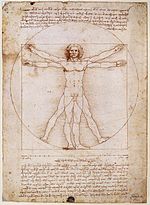
The Black Death pandemic in 1348 left its mark on Italy by killing one third of the population. However, the recovery from the disaster of the Black Death led to a resurgence of cities, trade and economy which greatly stimulated the successive phases of Humanism and Renaissance, cultural movements both born in the peninsula, and later spread in Europe.
In the 14th and 15th centuries, Northern and upper Central Italy were divided into a number of warring city-states, the rest of the peninsula being occupied by the larger Papal States and Naples. The strongest among these city-states annexed the surrounding territories giving birth to the Signorie, regional states led by merchant families which founded local dynasties. Dominated by merchant oligarchies, they enjoyed a relative freedom and nurtured academic and artistic advancement. Warfare between the states was common, invasion from outside Italy confined to intermittent sorties of Holy Roman Emperors. These wars were primarily fought by armies of mercenaries known as condottieri, bands of soldiers drawn from around Europe, but especially Germany and Switzerland, led largely by Italian captains.
Decades of fighting eventually saw Florence, Milan and Venice emerge as the dominant players that agreed to the Peace of Lodi in 1454, which saw relative calm brought to the region for the first time in centuries. This peace would hold for the next forty years, and Venice's unquestioned hegemony over the sea also led to unprecedented peace for much of the rest of the 15th century. The Italian Renaissance peaked in the mid-16th century as foreign invasions plunged the region into the turmoil of the Italian Wars.
The ideas and ideals of the Renaissance endured and spread into the rest of Europe, setting off the Northern Renaissance, French Renaissance, English Renaissance and other Renaissance movements across Europe. In the meantime, the discovery of the Americas, the new routes to Asia discovered by the Portuguese and the rise of the Ottoman Empire—all factors which eroded the traditional Italian dominance in trade with the East – started the economic decline of the peninsula.

Following the Italian Wars (1494 to 1559), Italy saw a long period of relative peace, first under Habsburg Spain (1559 to 1713) and then under Habsburg Austria (1713 to 1796). The plague repeatedly returned to haunt Italy throughout the 14th to 17th centuries. In the first half of the 17th century, a plague claimed some 1.7 million victims, or about 14% of Italy’s population. As Spain declined in the 17th century, so did its Italian possessions in Naples, Sicily, Sardinia, and Milan. Southern Italy was impoverished, stagnant, and cut off from the mainstream of events in Europe. Despite that, Italy kept making its contribution to the European culture, giving birth to the Baroque Style.
In the 18th century, as a result of the War of Spanish Succession, Austria replaced Spain as the dominant foreign power, while the House of Savoy emerged as a major regional power expanding to Piedmont and Sardinia. In this century, the ideas of the Enlightenment influenced the Italian rulers, paving the way to reforms which started an economic recovery in northern Italy and Tuscany.
During the Napoleonic Wars, the northern and central parts of the country were invaded and later partly annexed to the Empire and partly reorganized as a new Kingdom of Italy—essentially a client state of the French Empire — while the southern half of the peninsula was administered by Joachim Murat, Napoleon's brother-in-law, who was crowned as King of Naples. The 1814 Congress of Vienna restored the situation of the late 18th century, but the ideals of the French Revolution could not be eradicated.
Italian unification and Liberal Italy
The creation of the Kingdom of Italy was the result of efforts by Italian nationalists and monarchists loyal to the House of Savoy to establish a united state encompassing the entire Italian Peninsula. In the context of the 1848 liberal revolutions that swept through Europe, an unsuccessful war was declared on Austria. The Kingdom of Sardinia again attacked the Austrian Empire in the Second Italian War of Independence of 1859, with the aid of France, resulting in liberating Lombardy.
In 1860–61, Giuseppe Garibaldi led the drive for unification in Naples and Sicily, allowing the Sardinian government led by the Count of Cavour to declare a united Italian kingdom on 17 March 1861. In 1866, Victor Emmanuel II allied with Prussia during the Austro-Prussian War, waging the Third Italian War of Independence which allowed Italy to annex Venetia. Finally, as France during the disastrous Franco-Prussian War of 1870 abandoned its garrisons in Rome, the Savoy rushed to fill the power gap by taking over the Papal States.
The Sardinian Albertine Statute of 1848, extended to the whole Kingdom of Italy in 1861, provided for basic freedoms, but electoral laws excluded the non-propertied and uneducated classes from voting. The government of the new kingdom took place in a framework of parliamentary constitutional monarchy dominated by liberal forces. In 1913, male universal suffrage was adopted. As Northern Italy quickly industrialized, the South and rural areas of North remained underdeveloped and overpopulated, forcing millions of people to migrate abroad, while the Italian Socialist Party constantly increased in strength, challenging the traditional liberal and conservative establishment.
Starting from the last two decades of the 19th century, Italy developed into a colonial power by forcing Somalia, Eritrea and later Libya and the Dodecanese under its rule. During World War I, Italy at first stayed neutral, but in 1915 signed the secret Treaty of London, entering the Entente on the promise of receiving Trento, Trieste, Istria and Dalmatia from the Austro-Hungarian Empire—as well as parts of the Ottoman Empire. During the war, more than 650,000 Italian soldiers died, and the economy collapsed. Under the Peace Treaties of Saint-Germain, Rapallo and Rome, Italy obtained most of the promised territories, including the Hungarian harbour of Fiume, but not Dalmatia (except Zara), allowing nationalists to define the victory as "mutilated".
Fascist regime
The turbulence that followed the devastation of World War I, inspired by the Russian Revolution, led to turmoil and anarchy. The liberal establishment, fearing a socialist revolution, started to endorse the small National Fascist Party, led by Benito Mussolini. In October 1922 the fascists attempted a coup (the " March on Rome"). The coup itself was a failure, but at the last minute king Victor Emmanuel III faltered and appointed Mussolini prime minister. Over the next few years, Mussolini banned all political parties and curtailed personal liberties, thus forming a dictatorship.
In 1935, Mussolini invaded Ethiopia, resulting in an international alienation and leading to Italy's withdrawal from the League of Nations. Consequently, Italy allied with Nazi Germany and the Empire of Japan and strongly supported Franco in the Spanish civil war. In 1939, Italy occupied Albania, a de facto protectorate for decades. The aggressive policies of Italy in the interwar years undermined the collective security arrangements put in place after World War I, paving the way for World War II.
Italy entered World War II in June 1940 on the side of the Axis powers. After initially conquering British Somalia and parts of Egypt, the Italians saw an Allied counter-attack that ultimately lead to the loss of all their possessions in Africa. Mussolini, wanting a quick victory like Hitler's Blitzkriegs in Poland and France, invaded Greece in October 1940, but was forced to accept a humiliating stalemate after a few months.
After defeat in North Africa, Sicily was invaded by the Allies in July 1943, leading to the collapse of the Fascist regime and the fall of Mussolini. In September 1943, Italy surrendered. The Germans shortly succeeded in taking control of northern Italy. The country remained a battlefield for the rest of the war, as the Allies were moving up from the south.
In the north the Germans set up the Italian Social Republic (RSI), a German puppet state with Mussolini installed as leader. The post-armistice period saw the rise of the large anti-German Italian resistance movement. The hostilities ended on 2 May 1945 when the German forces in Italy surrendered. Nearly half a million Italians (including civilians) died in the conflict, and the Italian economy had been all but destroyed; per capita income in 1944 was at its lowest point since the beginning of the 20th century. Following the peace treaty of Paris (1947) Italy surrendered to Yugoslavia almost all the territories gained on the East border at the end of WWI, Briga and Tenda to France and lost its colonies. Albania was again independent.
Italian Republic
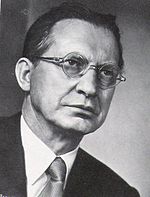
Italy became a republic after a referendum held on 2 June 1946, a day celebrated since as Republic Day. This was also the first time that Italian women were entitled to vote. Victor Emmanuel III's son, Umberto II, was forced to abdicate and exiled. The Republican Constitution was approved on 1 January 1948. Under the Treaty of Peace with Italy of 1947, most of Venezia Giulia was lost to Yugoslavia and, later, the Free Territory of Trieste was divided between the two states. Italy also lost all its colonial possessions, formally ending the Italian Empire.
Fears in the Italian electorate of a possible Communist takeover proved crucial for the first universal suffrage electoral outcome on 18 April 1948, when the Christian Democrats, under the leadership of Alcide De Gasperi, obtained a landslide victory. Consequently, in 1949 Italy became a member of NATO. The Marshall Plan helped to revive the Italian economy which, until the late 1960s, enjoyed a period of sustained economic growth commonly called the " Economic Miracle". In 1957, Italy was a founding member of the European Economic Community (EEC), which became the European Union (EU) in 1993.
From the late 1960s until the early 1980s, the country experienced the Years of Lead, a period characterized by economic crisis (especially after the 1973 oil crisis), widespread social conflicts and terrorist massacres carried out by opposing extremist groups, with the alleged involvement of US intelligence. The Years of Lead culminated in the assassination of the Christian Democrat leader Aldo Moro in 1978 and in the Bologna railway station massacre in 1980, where 85 people died; these events had deeply affected the whole country.
In the 1980s, for the first time since 1945, two governments were led by non-Christian-Democrat premiers: one liberal ( Giovanni Spadolini) and one socialist ( Bettino Craxi); the Christian Democrats remained, however, the main government party. During Craxi's government, the economy recovered and Italy became the world's fifth largest industrial nation, gaining entry into the G7 Group. However, as a result of his spending policies, the Italian national debt skyrocketed during the Craxi era, soon passing 100% of the GDP.
In the early 1990s, Italy faced significant challenges, as voters – disenchanted with political paralysis, massive public debt and the extensive corruption system (known as Tangentopoli) uncovered by the ' Clean Hands' investigation – demanded radical reforms. The scandals involved all major parties, but especially those in the government coalition: the Christian Democrats, who ruled for almost 50 years, underwent a severe crisis and eventually disbanded, splitting up into several factions. The Communists reorganized as a social-democratic force. During the 1990s and the 2000s (decade), centre-right (dominated by media magnate Silvio Berlusconi) and centre-left coalitions alternatively governed the country, which entered a prolonged period of economic stagnation.
Geography
Italy is located in Southern Europe and comprises the boot-shaped Italian Peninsula and a number of islands including the two largest, Sicily and Sardinia. It lies between latitudes 35° and 47° N, and longitudes 6° and 19° E.
The country's total area is 301,230 km², of which 294,020 km² is land and 7,210 km² is water. Including the islands, Italy has a coastline and border of 7,600 km on the Adriatic, Ionian, Tyrrhenian seas (740 km), and borders shared with France (488 km), Austria (430 km), Slovenia (232 km) and Switzerland (740 km). San Marino (39 km) and Vatican City (3.2 km), both enclaves, account for the remainder.
The Apennine Mountains form the peninsula's backbone and the Alps form most of its northern boundary, where Italy's highest point is located on Mont Blanc (4,810 m/15,782 ft). The Po, Italy's longest river (652 km/405 mi), flows from the Alps on the western border with France and crosses the Padan plain on its way to the Adriatic Sea. The five largest lakes are, in order of diminishing size: Garda (367.94 km2/142 sq mi), Maggiore (212.51 km2/82 sq mi, shared with Switzerland), Como (145.9 km2/56 sq mi), Trasimeno (124.29 km2/48 sq mi) and Bolsena (113.55 km2/44 sq mi).
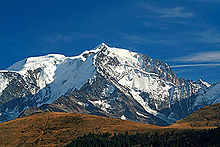
The country is situated at the meeting point of the Eurasian Plate and the African Plate, leading to considerable seismic and volcanic activity. There are 14 volcanoes in Italy, four of which are active: Etna (the traditional site of Vulcan’s smithy), Stromboli, Vulcano and Vesuvius. Vesuvius is the only active volcano in mainland Europe and is most famous for the destruction of Pompeii and Herculanum. Several islands and hills have been created by volcanic activity, and there is still a large active caldera, the Campi Flegrei north-west of Naples.
Although the country comprises the Italian peninsula and most of the southern Alpine basin, some of Italy's territory extends beyond the Alpine basin and some islands are located outside the Eurasian continental shelf. These territories are the comuni of: Livigno, Sexten, Innichen, Toblach (in part), Chiusaforte, Tarvisio, Graun im Vinschgau (in part), which are all part of the Danube's drainage basin, while the Val di Lei constitutes part of the Rhine's basin and the islands of Lampedusa and Lampione are on the African continental shelf.
Environment
After its quick industrial growth, Italy took a long time to confront its environmental problems. After several improvements, it now ranks 84th in the world for ecological sustainability. National parks cover about five percent of the country. In the last decade, Italy has become one of the world's leading producers of renewable energy, ranking as the world’s fourth largest holder of installed solar energy capacity and the sixth largest holder of wind power capacity in 2010. Renewable energies now make up about 12% of the total primary and final energy consumption in Italy, with a future target share set at 17% for the year 2020.
However, air pollution remains a severe problem, especially in the industrialised north, reaching the tenth highest level worldwide of industrial carbon dioxide emissions in the 1990s. Italy is the twelfth largest carbon dioxide producer. Extensive traffic and congestion in the largest metropolitan areas continue to cause severe environmental and health issues, even if smog levels have decreased dramatically since the 1970s and 1980s, and the presence of smog is becoming an increasingly rarer phenomenon and levels of sulphur dioxide are decreasing.
Many watercourses and coastal stretches have also been contaminated by industrial and agricultural activity, while because of rising water levels, Venice has been regularly flooded throughout recent years. Waste from industrial activity is not always disposed of by legal means and has led to permanent health effects on inhabitants of affected areas, as in the case of the Seveso disaster. The country has also operated several nuclear reactors between 1963 and 1990 but, after the Chernobyl disaster and a referendum on the issue the nuclear program was terminated, a decision that was overturned by the government in 2008, planning to build up to four nuclear power plants with French technology. This was in turn struck down by a referendum following the Fukushima nuclear accident.
Deforestation, illegal building developments and poor land-management policies have led to significant erosion all over Italy's mountainous regions, leading to major ecological disasters like the 1963 Vajont Dam flood, the 1998 Sarno and 2009 Messina mudslides.
Climate
Thanks to the great longitudinal extension of the peninsula and the mostly mountainous internal conformation, the climate of Italy is highly diverse. In most of the inland northern and central regions, the climate ranges from humid subtropical to humid continental and oceanic. In particular, the climate of the Po valley geographical region is mostly continental, with harsh winters and hot summers.
The coastal areas of Liguria, Tuscany and most of the South generally fit the Mediterranean climate stereotype ( Köppen climate classification Csa). Conditions on peninsular coastal areas can be very different from the interior's higher ground and valleys, particularly during the winter months when the higher altitudes tend to be cold, wet, and often snowy. The coastal regions have mild winters and warm and generally dry summers, although lowland valleys can be quite hot in summer. Average winter temperatures vary from 0 °C (32 °F) on the Alps to 12 °C (54 °F) in Sicily, like so the average summer temperatures range from 20 °C (68 °F) to over 30 °C (86 °F).
Politics
Italy has been a unitary parliamentary republic since 2 June 1946, when the monarchy was abolished by a constitutional referendum. The President of the Italian Republic (Presidente della Repubblica), currently Giorgio Napolitano since 2006, is Italy's head of state. The President is elected for a single seven years mandate by the Parliament of Italy in joint session. Italy has a written democratic constitution, resulting from the work of a Constituent Assembly formed by the representatives of all the anti-fascist forces that contributed to the defeat of Nazi and Fascist forces during the Civil War.
Government
Italy has a parliamentary government based on a proportional voting system. The parliament is perfectly bicameral: the two houses, the Chamber of Deputies (that meets in Palazzo Montecitorio) and the Senate of the Republic (that meets in Palazzo Madama), have the same powers. The Prime Minister, officially President of the Council of Ministers (Presidente del Consiglio dei Ministri), is Italy's head of government. The Prime Minister and the cabinet are appointed by the President of the Republic, but must pass a vote of confidence in Parliament to become in office.
While the office is similar to those in most other parliamentary systems, the Italian prime minister has less authority than some of his counterparts. The prime minister is not authorized to request the dissolution of Parliament or dismiss ministers (that are exclusive prerogatives of the President of the Republic) and must receive a vote of approval from the Council of Ministers—which holds effective executive power—to execute most political activities.
After the resignation of Silvio Berlusconi on 12 November 2011, economist Mario Monti has been appointed as a technocratic Prime Minister. The Italy's four major political parties are the People of Freedom, the Democratic Party, the Northern League and the Union of Christian and Centre Democrats (UDC). During the 2008 general elections these four parties won 589 out of 630 seats available in the Chamber of Deputies and 293 out of 315 seats available in the Senate of the Republic.
Most of the remaining seats were won by minor parties that only contest election in one part of Italy, like the South Tyrolean People's Party and the Movement for Autonomies. However, during the last 3 years, a so-called " Third Pole" emerged, merging the Christian Democrats of UDC with some dissident MPs coming from Mr. Berlusconi's cabinet.
A peculiarity of the Italian Parliament is the representation given to Italian citizens permanently living abroad: 12 Deputies and 6 Senators elected in four distinct overseas constituencies. In addition, the Italian Senate is characterized also by a small number of senators for life, appointed by the President "for outstanding patriotic merits in the social, scientific, artistic or literary field". Former Presidents of the Republic are ex officio life senators.
Law and criminal justice
The Italian judicial system is based on Roman law modified by the Napoleonic code and later statutes. The Supreme Court of Cassation is the highest court in Italy for both criminal and civil appeal cases. The Constitutional Court of Italy (Corte Costituzionale) rules on the conformity of laws with the constitution and is a post–World War II innovation. Since their appearance in the middle of the 19th century, Italian organized crime and criminal organizations have infiltrated the social and economic life of many regions in Southern Italy, the most notorious of which being the Sicilian Mafia, which would later expand into some foreign countries including the United States. The Mafia receipts may reach 9% of Italy's GDP.
A 2009 report identified 610 comuni which have a strong Mafia presence, where 13 million Italians live and 14.6% of the Italian GDP is produced. The Calabrian 'Ndrangheta, nowadays probably the most powerful crime syndicate of Italy, accounts alone for 3% of the country's GDP. However, at 0.013 per 1,000 people, Italy has only the 47th highest murder rate (in a group of 62 countries) and the 43rd highest number of rapes per 1,000 people in the world (in a group of 65 countries), relatively low figures among developed countries.
Foreign relations
Italy is a founding member of the European Community, now the European Union (EU), and of the North Atlantic Treaty Organization (NATO). Italy was admitted to the United Nations in 1955, and it is a member and strong supporter of a wide number of international organizations, such as the Organisation for Economic Co-operation and Development (OECD), the General Agreement on Tariffs and Trade/World Trade Organization (GATT/WTO), the Organization for Security and Co-operation in Europe (OSCE), the Council of Europe, and the Central European Initiative. Its recent turns in the rotating presidency of international organisations include the Conference for Security and Co-operation in Europe (CSCE), the forerunner of the OSCE, in 1994; G8; and the EU in 2009 and from July to December 2003.
Italy strongly supports multilateral international politics, endorsing the United Nations and its international security activities. Italy deployed troops in support of UN peacekeeping missions in Somalia, Mozambique, and East Timor and provides support for NATO and UN operations in Bosnia, Kosovo and Albania. Italy deployed over 2,000 troops in Afghanistan in support of Operation Enduring Freedom (OEF) from February 2003. Italy still supports international efforts to reconstruct and stabilize Iraq, but it has withdrawn its military contingent of some 3,200 troops as of November 2006, maintaining only humanitarian operators and other civilian personnel. In August 2006 Italy deployed about 2,450 troops in Lebanon for the United Nations' peacekeeping mission UNIFIL.
Military
The Italian Army, Navy, Air Force and Carabinieri collectively form the Italian armed forces, under the command of the Supreme Defence Council, presided over by the President of the Italian Republic. From 2005, military service is entirely voluntary. In 2010, the Italian military had 293,202 personnel on active duty, of which 114,778 are Carabinieri. Total Italian military spending in 2010 ranked tenth in the world, standing at $35.8 billion, equal to 1.7% of national GDP. As part of NATO's nuclear sharing strategy Italy also hosts 90 United States nuclear bombs, located in the Ghedi and Aviano air bases.
The Italian Army is the national ground defense force, numbering 109,703 in 2008. Its best-known combat vehicles are the Dardo infantry fighting vehicle, the Centauro tank destroyer and the Ariete tank, and among its aircraft the Mangusta attack helicopter, recently deployed in UN missions. It also has at its disposal a large number of Leopard 1 and M113 armored vehicles.
The Italian Navy in 2008 had 35,200 active personnel with 85 commissioned ships and 123 aircraft. It is now equipping itself with a bigger aircraft carrier (the Cavour), new destroyers, submarines and multipurpose frigates. In modern times the Italian Navy, being a member of the NATO, has taken part in many coalition peacekeeping operations around the world.
The Italian Air Force in 2008 had a strength of 43,882 and operated 585 aircraft, including 219 combat jets and 114 helicopters. As a stopgap and as replacement for leased Tornado ADV interceptors, the AMI has leased 30 F-16A Block 15 ADF and four F-16B Block 10 Fighting Falcons, with an option for more. The coming years will also see the introduction of 121 EF2000 Eurofighter Typhoons, replacing the leased F-16 Fighting Falcons. Further updates are foreseen in the Tornado IDS/IDT and AMX fleets. A transport capability is guaranteed by a fleet of 22 C-130Js and Aeritalia G.222s of which 12 are being replaced with the newly developed G.222 variant called the C-27J Spartan.
An autonomous corps of the military, the Carabinieri are the gendarmerie and military police of Italy, policing the military and civilian population alongside Italy's other police forces. While the different branches of the Carabinieri report to separate ministries for each of their individual functions, the corps reports to the Ministry of Internal Affairs when maintaining public order and security.
Administrative divisions
Italy is subdivided into 20 regions (regioni, singular regione), five of these regions having a special autonomous status that enables them to enact legislation on some of their local matters. The country is further divided into 110 provinces (province) and 8,100 municipalities (comuni). There are also 15 metropolitan cities (città metropolitane), established in 2009, but this administrative division is not yet operational.
Venezia Giulia
Valley
Alto Adige
Südtirol
| Region | Capital | Area (km²) | Area (sq mi) | Population |
|---|---|---|---|---|
| Abruzzo | L'Aquila | 10,763 | 4,156 | 1,342,177 |
| Aosta Valley | Aosta | 3,263 | 1,260 | 128,129 |
| Apulia | Bari | 19,358 | 7,474 | 4,090,577 |
| Basilicata | Potenza | 9,995 | 3,859 | 587,680 |
| Calabria | Catanzaro | 15,080 | 5,822 | 2,011,537 |
| Campania | Naples | 13,590 | 5,247 | 5,833,131 |
| Emilia-Romagna | Bologna | 22,446 | 8,666 | 4,429,766 |
| Friuli-Venezia Giulia | Trieste | 7,858 | 3,034 | 1,235,761 |
| Lazio | Rome | 17,236 | 6,655 | 5,724,365 |
| Liguria | Genoa | 5,422 | 2,093 | 1,616,993 |
| Lombardy | Milan | 23,844 | 9,206 | 9,909,348 |
| Marche | Ancona | 9,366 | 3,616 | 1,564,886 |
| Molise | Campobasso | 4,438 | 1,713 | 319,834 |
| Piedmont | Turin | 25,402 | 9,808 | 4,456,532 |
| Sardinia | Cagliari | 24,090 | 9,301 | 1,675,286 |
| Sicily | Palermo | 25,711 | 9,927 | 5,050,486 |
| Tuscany | Florence | 22,993 | 8,878 | 3,749,074 |
| Trentino-Alto Adige/Südtirol | Trento | 13,607 | 5,254 | 1,036,639 |
| Umbria | Perugia | 8,456 | 3,265 | 906,675 |
| Veneto | Venice | 18,399 | 7,104 | 4,936,197 |
Economy
Italy has a free market economy characterized by high per capita GDP and low unemployment rates. In 2010, it was the eighth-largest economy in the world and the fourth-largest in Europe in terms of nominal GDP, and the tenth-largest economy in the world and fifth-largest in Europe in terms of PPP. It is a founding member of the G8, the Eurozone and the OECD.
After World War II, Italy was rapidly transformed from an agriculture based economy into one of the world's most industrialized nations and a leading country in world trade and exports. It is a developed country, with the world's 8th highest quality of life in 2005 and the 24th Human Development Index. In spite of the recent global economic crisis, Italian per capita GDP at purchasing power parity remains approximately equal to the EU average, while the unemployment rate (8.5%) stands as one of the EU's lowest. The country is well known for its influential and innovative business economic sector, an industrious and competitive agricultural sector (Italy is the world's largest wine producer), and for its creative and high-quality automobile, industrial, appliance and fashion design.
Italy has a smaller number of global multinational corporations than other economies of comparable size, but there is a large number of small and medium-sized enterprises, notoriously clustered in several industrial districts, which are the backbone of the Italian industry. This has produced a manufacturing sector often focused on the export of niche market and luxury products, that if on one side is less capable to compete on the quantity, on the other side is more capable of facing the competition from China and other emerging Asian economies based on lower labour costs, with higher quality products.
The country was the world's 7th largest exporter in 2009. Italy's closest trade ties are with the other countries of the European Union, with whom it conducts about 59% of its total trade. Its largest EU trade partners, in order of market share, are Germany (12.9%), France (11.4%), and Spain (7.4%). Finally, tourism is one of the fastest growing and profitable sectors of the national economy: with 43.6 million international tourist arrivals and total receipts estimated at $38.8 billion in 2010, Italy is both the fifth most visited country and highest tourism earner in the world.
Despite these important achievements, the Italian economy today suffers from many and relevant problems. After a strong GDP growth of 5–6% per year from the 1950s to the early 1970s, and a progressive slowdown in the 1980s and 1990s, the last decade's average annual growth rates poorly performed at 1.23% in comparison to an average EU annual growth rate of 2.28%. The stagnation in economic growth, and the political efforts to revive it with massive government spending from the 1980s onwards, eventually produced a severe rise in public debt. According to the EU's statistics body Eurostat, Italian public debt stood at 116% of GDP in 2010, ranking as the second biggest debt ratio after Greece (with 126.8%).
However, the biggest chunk of Italian public debt is owned by national subjects, a major difference between Italy and Greece. In addition, Italian living standards have a considerable north-south divide. The average GDP per capita in the north exceeds by far the EU average, while many regions of Southern Italy are dramatically below. Italy has often been referred the sick man of Europe, characterised by economic stagnation, political instability and problems in pursuing reform programs.
More specifically, Italy suffers from structural weaknesses because of its geographical conformation and the lack of raw materials and energy resources: in 2006 the country imported more than 86% of its total energy consumption (99.7% of the solid fuels, 92.5% of oil, 91.2% of natural gas and 15% of electricity). The Italian economy is weakened by the lack of infrastructure development, market reforms and research investment, and also high public deficit. In the Index of Economic Freedom 2008, the country ranked 64th in the world and 29th in Europe, the lowest rating in the Eurozone. Italy still receives development assistance from the European Union every year. Between 2000 and 2006, Italy received €27.4 billion from the EU.
The country has an inefficient state bureaucracy, low property rights protection and high levels of corruption, heavy taxation and public spending that accounts for about half of the national GDP. In addition, the most recent data show that Italy's spending in R&D in 2006 was equal to 1.14% of GDP, below the EU average of 1.84% and the Lisbon Strategy target of devoting 3% of GDP to research and development activities. According to the Confesercenti, a major business association in Italy, organized crime in Italy represented the "biggest segment of the Italian economy", accounting for €90 billion in receipts and 7% of Italy's GDP.
Moreover, the big gap between the wealthy Centre-North of country and the poorer South, remains unresolved, following several decades of failing politics to develop the Mezzogiorno. Today, while the North and the Centre of the country have a GDP per capita which is about 115-125% of EU average, with the North being one of the industrial cores of Europe, the South has a GDP per capita which is just the 70% of EU average. South Italy also sees bigger levels of unemployment, corruption, organised crime and "black economy", and as well its economy depends more on State-funded industry or on State-related jobs, rather than private enterprises.
Infrastructure
In 2004 the transport sector in Italy generated a turnover of about 119.4 billion euros, employing 935,700 persons in 153,700 enterprises. Regarding the national road network, in 2002 there were 668,721 km (415,524 mi) of serviceable roads in Italy, including 6,487 km (4,031 mi) of motorways, state-owned but privately operated by Atlantia. In 2005, about 34,667,000 passenger cars (590 cars per 1,000 people) and 4,015,000 goods vehicles circulated on the national road network.
The national railway network, state-owned and operated by Ferrovie dello Stato, in 2003 totalled 16,287 km (10,120 mi) of which 69% is electrified, and on which 4,937 locomotives and railcars circulated. The national inland waterways network comprised 1,477 km (918 mi) of navigable rivers and channels in 2002. In 2004 there were approximately 30 main airports (including the two hubs of Malpensa International in Milan and Leonardo Da Vinci International in Rome) and 43 major seaports (including the seaport of Genoa, the country's largest and second largest in the Mediterranean Sea). In 2005 Italy maintained a civilian air fleet of about 389,000 units and a merchant fleet of 581 ships.
Demographics
Italy has 60,626,442 inhabitants according to 1 January 2011 municipal records (Anagrafe). Its population density, at 201/km² (520/sq. mile), is higher than that of most Western European countries. However the distribution of the population is widely uneven. The most densely populated areas are the Po Valley (that accounts for almost a half of the national population) and the metropolitan areas of Rome and Naples, while vast regions such as the Alps and Apennines highlands, the plateaus of Basilicata and the island of Sardinia are very sparsely populated.
The population of Italy almost doubled during the 20th century, but the pattern of growth was extremely uneven because of large-scale internal migration from the rural South to the industrial cities of the North, a phenomenon which happened as a consequence of the Italian economic miracle of the 1950–1960s. In addition, after centuries of net emigration, from the 1980s Italy has experienced large-scale immigration for the first time in modern history. According to the Italian government, there were 4,570,317 foreign residents in Italy as of January 2011.
High fertility and birth rates persisted until the 1970s, after which they start to dramatically decline, leading to rapid population aging. At the end of the 2000s (decade), one in five Italians was over 65 years old. However, thanks mainly to the massive immigration of the last two decades, in recent years Italy experienced a significant growth in birth rates. The total fertility rate has also climbed from an all-time low of 1.18 children per woman in 1995 to 1.41 in 2008. The TFR is expected to reach 1.6 - 1.8 in 2030.
| Largest cities or towns of Italy ISTAT estimates for 31 December 2010 |
|||||||||
|---|---|---|---|---|---|---|---|---|---|
| Rank | City name | Region | Pop. | Rank | City name | Region | Pop. | ||
 Rome |
1 | Rome | Lazio | 2,761,477 | 11 | Venice | Veneto | 270,884 |  Naples |
| 2 | Milan | Lombardy | 1,324,110 | 12 | Verona | Veneto | 263,964 | ||
| 3 | Naples | Campania | 963,357 | 13 | Messina | Sicily | 242,503 | ||
| 4 | Turin | Piedmont | 907,563 | 14 | Padua | Veneto | 214,198 | ||
| 5 | Palermo | Sicily | 655,875 | 15 | Trieste | Friuli-Venezia Giulia | 205,535 | ||
| 6 | Genoa | Liguria | 607,906 | 16 | Brescia | Lombardy | 193,879 | ||
| 7 | Bologna | Emilia-Romagna | 380,181 | 17 | Taranto | Apulia | 191,810 | ||
| 8 | Florence | Tuscany | 371,282 | 18 | Prato | Tuscany | 188,011 | ||
| 9 | Bari | Apulia | 320,475 | 19 | Parma | Emilia-Romagna | 186,690 | ||
| 10 | Catania | Sicily | 293,458 | 20 | Reggio Calabria | Calabria | 186,547 | ||
Ethnic groups
Foreign population resident in Italy.
Italy was a country of mass emigration from the late 19th century until the 1960s. Between 1898 and 1914, the peak years of Italian diaspora, approximately 750,000 Italians emigrated each year. The diaspora concerned more than 25 million Italians and it is considered the biggest mass migration of contemporary times. As a result, today more than 4.1 million Italian-born people are living abroad, while at least 60 million people of full or part Italian ancestry live outside of Italy, most notably in Argentina, Brazil, Uruguay, Venezuela, the United States, Canada, Australia, and France.
The postwar economic miracle, ending many decades of poverty and emigration, induced big social changes such as lower birth rates, an aging population and thus a shrinking workforce. Under these circumstances, starting from the late 1970s, Italy became to attract increasing flows of foreign immigrants. The present-day figure of about 4.6 million foreign residents, making up some 7.5% of the total population, include more than half a million children born in Italy to foreign nationals—second generation immigrants, but exclude foreign nationals who have subsequently acquired Italian nationality; this applied to 53,696 people in 2008.
The official figures also exclude illegal immigrants, whose numbers are very difficult to determine; they are estimated to be at least 670,000. Since the fall of the Berlin Wall and, more recently, the 2004 and 2007 enlargements of the European Union, the main waves of migration have originated from former socialist countries of Eastern Europe (especially Romania, Albania, Ukraine and Poland). The second most important area of immigration to Italy has always been the neighbouring North Africa (in particular, Morocco, Egypt and Tunisia), with soaring arrivals as a consequence of the Arab Spring. Furthermore, in recent years, growing migration fluxes from the Far East (notably, China and the Philippines) and Latin America (Ecuador, Peru) have been recorded.
Currently, about one million Romanians (around one tenth of them being Roma) are officially registered as living in Italy, representing thus the most important individual country of origin, followed by Albanians and Moroccans with about 500,000 people each. The number of unregistered Romanians is difficult to estimate, but the Balkan Investigative Reporting Network suggested that in 2007 that there might have been half a million or more.
Overall, at the end of 2000s (decade) the foreign born population of Italy was from: Europe (54%), Africa (22%), Asia (16%), the Americas (8%) and Oceania (0.06%). The distribution of immigrants is largely uneven in Italy: 87% of immigrants live in the northern and central parts of the country (the most economically developed areas), while only 13% live in the southern half of the peninsula.
Languages
Italy's official language is Italian. Ethnologue has estimated that there are about 55 million speakers of the language in Italy and a further 6.7 million outside of the country. However, between 120 and 150 million people use Italian as a second or cultural language, worldwide.
Italian, adopted by the state after the unification of Italy, is based on the Florentine variety of Tuscan and is somewhat intermediate between the Italo-Dalmatian languages and the Gallo-Romance languages.
Italy has numerous dialects spoken all over the country and some Italians cannot speak Italian at all. However, the establishment of a national education system has led to decrease in variation in the languages spoken across the country. Standardisation was further expanded in the 1950s and 1960s thanks to economic growth and the rise of mass media and television (the state broadcaster RAI helped set a standard Italian).
Several linguistic groups are legally recognized, and a number of minority languages have co-official status alongside Italian in various parts of the country. French is co-official in the Valle d’Aosta—although in fact Franco-Provencal is more commonly spoken there. German has the same status in the province of South Tyrol as, in some parts of that province and in parts of the neighbouring Trentino, does Ladin. Slovene is officially recognised in the provinces of Trieste, Gorizia and Udine in Friuli Venezia Giulia.
In these regions official documents are bilingual (trilingual in Ladin communities), or available upon request in either Italian or the co-official language. Traffic signs are also multilingual, except in the Valle d’Aosta where – with the exception of Aosta itself which has retained its Latin form in Italian (as in English) – French toponyms are generally used, attempts to italianise them during the Fascist period having been abandoned. Education is possible in minority languages where such schools are operating.
Religion
Roman Catholicism is by far the largest religion in the country, although Catholicism is no longer officially the state religion. The proportion of Italians that identify themselves as Roman Catholic is 87.8%, although only about one-third of these described themselves as active members (36.8%). Most Italians believe in God, or a form of a spiritual life force. According to the most recent Eurobarometer Poll 2005: 74% of Italian citizens responded that 'they believe there is a God', 16% answered that 'they believe there is some sort of spirit or life force' and 6% answered that 'they do not believe there is any sort of spirit, God, or life force'.
The Italian Catholic Church is part of the global Roman Catholic Church, under the spiritual leadership of the Pope, curia in Rome, and the Conference of Italian Bishops. In addition to Italy, two other sovereign nations are included in Italian-based dioceses, the enclaves of San Marino and Vatican City. There are 225 dioceses in the Italian Catholic Church, see further in this article and in the article List of the Roman Catholic dioceses in Italy.
Italy has a rich Roman Catholic culture, especially as numerous Catholic saints, martyrs and popes were Italian themselves. All of the popes from 1523 to 1978 were from what is now Italy. Italy is also home to the greatest number of cardinals in the world, and is the country with the greatest number of Roman Catholic churches per capita.
Minority Christian faiths in Italy include Waldensians, and Eastern Orthodox as well as some Protestant churches. In the 20th century, Pentecostalism, non-denominational Evangelicalism, were the fastest-growing Protestant churches, as well as Jehovah's Witnesses and Mormonism. Starting from the 1980s, immigration from Subsaharan Africa has increased the size of Baptist, Anglican, Pentecostal and Evangelical communities in Italy, while immigration from Eastern Europe has established large Eastern Orthodox communities.
At the beginning of the 21st century, there were more than 700,000 Eastern Orthodox Christians in Italy, including 180,000 Greek Orthodox, 550,000 Pentecostals and Evangelists (0.8%), of whom 400,000 are members of the Assemblies of God, 235,685 Jehovah's Witnesses (0.4%), 30,000 Waldensians, 25,000 Seventh-day Adventists, 22,000 Mormons, 15,000 Baptists (plus some 5,000 Free Baptists), 7,000 Lutherans, 4,000 Methodists (affiliated with the Waldensian Church).
One of the longest-established minority religious faiths in Italy is Judaism, Jews having been present in Ancient Rome since before the birth of Christ. There have been many influential Italian-Jews, such as Shabbethai Donnolo (died in 982), prime minister Luigi Luzzatti, who took office in 1910, and Ernesto Nathan, outstanding mayor of Rome from 1907 to 1913. During the Holocaust, Italy took in many Jewish refugees from Nazi Germany. However, with the creation of the Nazi-backed puppet Italian Social Republic, about 15% of Italy's Jews were killed, despite the Fascist government's refusal to deport Jews to Nazi death camps. This, together with the emigration that preceded and followed the World War II, has left only a small community of around 45,000 Jews in Italy today.
Rising immigration has been accompanied by an increase in non-Christian faiths. In 2009, there were one million Muslims in Italy forming 1.6 percent of population, although only 50,000 hold Italian citizenship. Independent estimates put the Islamic population in Italy anywhere from 0.8 million to 1.5 million. There are more than 200,000 followers of faiths originating in the Indian subcontinent with some 70,000 Sikhs with 22 gurdwaras across the country, 70,000 Hindus, and 50,000 Buddhists. There were an estimated some 4,900 Bahá'ís in Italy in 2005.
Education
Education in Italy is free and mandatory from ages six to sixteen, and consists of five stages: kindergarten (scuola dell'infanzia), primary school (scuola primaria), lower secondary school (scuola secondaria di primo grado), upper secondary school (scuola secondaria di secondo grado) and university (università). The Superior Graduate Schools are independent institution similar to French Grandes écoles which offer advanced training and research through university-type courses or are dedicated to teaching at graduate or post-doctoral level.
Italy hosts a broad variety of universities, colleges and academies. Founded in 1088, the University of Bologna is likely the oldest in the world. In 2009, the University of Bologna is, according to The Times, the only Italian college in the top 200 World Universities. Milan's Bocconi University has been ranked among the top 20 best business schools in the world by The Wall Street Journal international rankings, especially thanks to its M.B.A. program, which in 2007 placed it no. 17 in the world in terms of graduate recruitment preference by major multinational companies. Bocconi was also ranked by Forbes as the best worldwide in the specific category Value for Money. In May 2008, Bocconi overtook several traditionally top global business schools in the Financial Times Executive education ranking, reaching no. 5 in Europe and no. 15 in the world.
Other top universities and polytechnics include the Polytechnic University of Turin, the Politecnico di Milano (which in 2011 was ranked as the 48th best technical university in the world by QS World University Rankings), the University of Rome La Sapienza (which in 2005 was Europe's 33rd best university, and ranks among Europe's 50 and the world's 150 best colleges) and the University of Milan (whose research and teaching activities have developed over the years and have received important international recognitions). The University is the only Italian member of the League of European Research Universities (LERU), a prestigious group of twenty research-intensive European Universities. It has also been awarded ranking positions such as 1st in Italy and 7th in Europe (The Leiden Ranking – Universiteit Leiden).
According to National Science Indicators (1981–2002), a database produced by Research Services Group containing listings of output and citation statistics for more than 90 countries, Italy has an above-average output of scientific papers (in terms of number of papers written with at least one author being from Italy) in space science (9.75% of papers in the world being from Italy), mathematics (5.51% of papers in the world), computer science, neurosciences, and physics; the lowest, but still slightly above world-average, output in terms of number of papers produced is recorded in the social sciences, psychology and psychiatry, and economics and business.
Healthcare
The Italian state runs a universal public healthcare system since 1978. However, healthcare is provided to all citizens and residents by a mixed public-private system. The public part is the Servizio Sanitario Nazionale, which is organized under the Ministry of Health and administered on a devolved regional basis. Healthcare spending in Italy accounted for more than 9.0% of the national GDP in 2008, slightly above the OECD countries' average of 8.9%.
Italy ranks as having the world's 2nd best healthcare system, and the world's 3rd best healthcare performance. Italy had the 12th highest worldwide life expectancy in 2010. As in many others western countries, seeing an increase in the proportion of overweight and obese people, with 34.2% of Italians self reporting as overweight and 9.8% self reporting as obese. The proportion of daily smokers was 22% in 2008. Smoking in public places including bars, restaurants, night clubs and offices has been restricted to specially ventilated rooms since 2005.


![Location of Italy (dark green)– in Europe (green & dark grey)– in the European Union (green) — [Legend]](../../images/2619/261979.png)

